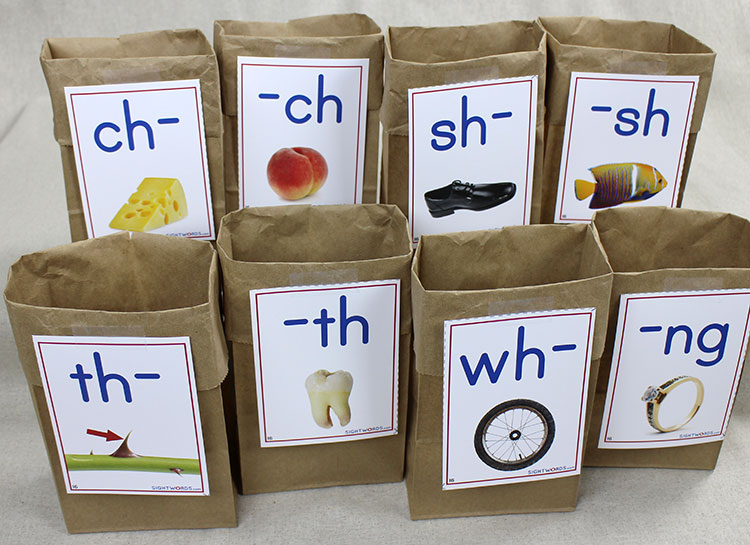I 6: Sorting Sacks
1. Overview
See a picture card and decide which “special sound” (digraph) is in the word and whether it comes at the beginning or end of the word. Then put the picture card in the appropriate sack.
I6: Sorting Sacks
2. Materials & Preparation
- Script
- 8 small paper sacks
- *See option below.
- labels to put on the sacks
- picture cards — these are the same picture cards used in Heads or Tails, Part 1
- word index
3. Activity
Video: How to play Sorting Sacks
Before starting the game, do a quick review of the digraph sounds, using the labels on the sacks. Explain that on the sack labels, a dash in front of the sound (e.g., -ch) means the special sound comes at the end (or tail) of the word, but a dash after the sound (e.g., ch-) means the special sound comes at the beginning (or head) of the word. Use the pictures on the label cards to demonstrate.
Adult: Ch-. Cheese. /ch/ is at the start — the head — of cheese.Now introduce and demonstrate the game for your child. He will turn over a picture card, say the word, and decide which sack it should go in.
Adult: Okay, turn over the first picture card. What is it? Child: A watch! Adult: That’s right. Which sack does it belong in? Child: [points to ch-] That one? Adult: Are you sure? Say the name of the picture. Child: Cheese. It has a /ch/! Adult: Yes, but listen to where the /ch/ sound is: cheese. Is the /ch/ sound at the beginning or the end of cheese? Child: The beginning. Adult: Now look at your picture card and say the word. Child: Watch. Adult: Is the /ch/ sound at the beginning or the end of watch? Child: The end! Adult: Right. So which sack has the /ch/ sound at the end? Child: Um…that one! Peach! Adult: Good job. Put the watch card in the peach sack.Go through at least 20 words in a session, in random order so the child gets a mix of special sounds at both the beginning and end. Make note of any words or digraphs the child is struggling with, and revisit those words at the end. ↑ Top
4. Extension
Time how long it takes the child to correctly sort 20 picture cards into sacks. Then shuffle the picture cards and play the game again, challenging the child to beat his own time by sorting the cards faster! ↑ Top5. Small Groups (2-5 children)
Lesson Objective: Aided by picture cards and digraph letter cards, children will say the name of the pictured item, isolate the digraph phoneme, determine whether the phoneme comes at the beginning or the end of the word, and sort the picture into sacks labelled with beginning and ending digraphs. GELDS (Georgia Early Learning & Development Standards): CLL6.4f Georgia Standards of Excellence: ELAGSEKRF3.a Common Core State Standards: CCSS.ELA-LITERACY.RF.K.3.A Additional Materials:- optional: second set of sack labels, to label both sides of each sack for better visibility
Leave a Reply

One Response to “I 6: Sorting Sacks”
Meghan Holliday
This was a great tool. However, I wish it separated them by beginning and ending. It is too difficult for students to navigate BOTH.